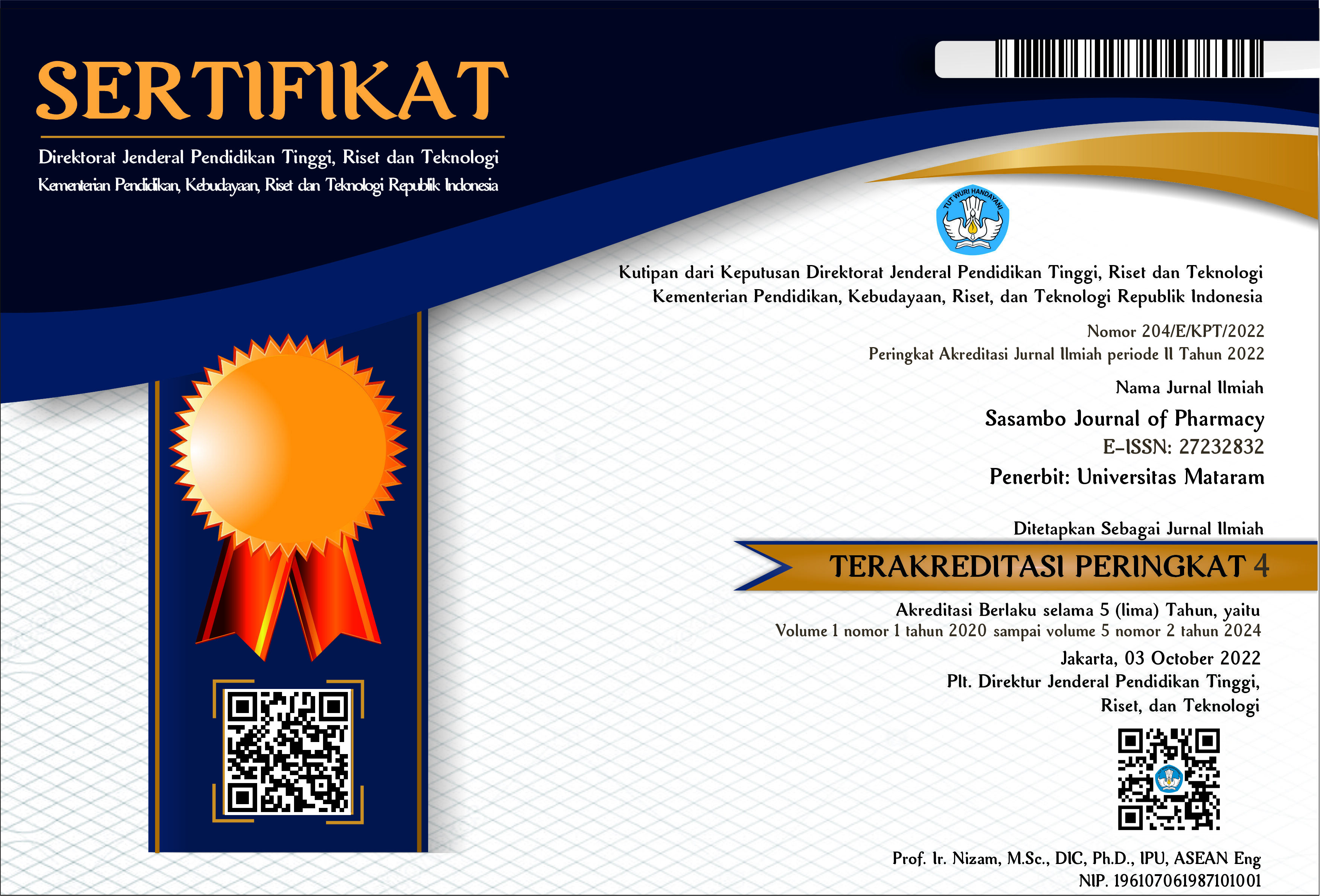Incidence of Klebsiella pneumoniae producing Metallo Beta-Lactamase (MBL) at RSUP Dr. Wahidin Sudirohusodo Makassar
DOI:
10.29303/sjp.v3i1.111Downloads
Abstract
Bacterial resistance to antibiotic is one of the factors triggering infection therapy failure. This study was conducted to determine the prevalence of carbapenem-resistance Klebsiella pneumoniae infection and the phenotype of carbapenem-resistant Metallo-Beta-Lactamase (MBL)-producing Klebsiella pneumoniae isolates at RSUP Dr. Wahidin Sudirohusodo Makassar. This study included Klebsiella pneumoniae identification on each infectious patient’s isolates. The sensitivity test of antibiotics, phenotype confirmatory test, and MBL phenotypic test were conducted using agar diffusion Kirby-Bauer, Vitek-2-Compact, and Double Disc Synergy Test (DDST) method, respectively. As the result, the antibiotic sensitivity test using the Vitek-2-Compact method on 50 clinical samples (pus, sputum, blood. tissue, urine, brain fluid, and feces) found that 10 isolates (20%) were resistant to carbapenem. The phenotypic test using the Double Disc Synergy Test (DDST) method found that carbapenem-resistant isolates caused by the production of Metallo Beta Lactamase (MBL) enzymes were 2 isolates or 20% of the total carbapenem-resistant isolates.
Keywords:
Carbapenem, Double Disc Synergy Test (DDST), Klebsiella pneumoniae, Metallo-Beta-LactamaseReferences
Bora, A., Sanjana, R., Jha, B. K., Mahaseth, S. N., & Pokharel, K. (2014). Incidence of metallo-beta-lactamase producing clinical isolates of Escherichia coli and Klebsiella pneumoniae in central Nepal. BMC Res Notes 7, 557. https://doi.org/10.1186/1756-0500-7-557
Chandler, C. (2017). Antibiotic prescribing and resistance: Views from low - and middle - income prescribing and dispensing professionals.
Dellinger, R. P., Levy, M. M., Rhodes, A., Annane, D., Gerlach, H., Opal, S. M., Sevransky, J. E., Sprung, C. L., Douglas, I. S., Jaeschke, R., Osborn, T. M., Nunnally, M. E., Townsend, S. R., Reinhart, K., Kleinpell, R. M., Angus, D. C., Deutschman, C. S., Machado, F. R., Rubenfeld, G. D., Webb, S. A., Beale, R. J., Vincent, J., Moreno, R., & the Surviving Sepsis Campaign Guidelines Committee including the Pediatric Subgroup. (2013). Surviving Sepsis Campaign. Critical Care Medicine, 41(2), 580-637 doi: 10.1097/CCM.0b013e31827e83af
Nepal, K., Pant, N. D., Neupane, B., Belbase, A., Baidhya, R., Shrestha, R. K., Lekhak, B., Bhatta, D. R., & Jha, B. (2017). Extended spectrum beta-lactamase and metallo beta-lactamase production among Escherichia coli and Klebsiella pneumoniae isolated from different clinical samples in a tertiary care hospital in Kathmandu, Nepal. Annals of clinical microbiology and antimicrobials, 16(1), 62. https://doi.org/10.1186/s12941-017-0236-7
Panchal, C. A., Oza, S. S., & Mehta, S. J. (2017). Comparison of four phenotypic methods for detection of metallo-β-lactamase-producing Gram-negative bacteria in rural teaching hospital. Journal of Laboratory Physicians., 9(2), 81-83. doi:10.4103/0974-2727.199624
Papp-Wallace, K. M., Endimiani, A., Taracila, M. A., & Bonomo, R. A. (2011). Carbapenems: past, present, and future. Antimicrobial agents and chemotherapy, 55(11), 4943–4960. https://doi.org/10.1128/AAC.00296-11
Parathon, H., Kuntaman, K., Widiastoety, T. H., Muliawan, B. T., Karuniawati, A., Qibtiyah, M., Djanun, Z., Tawilah, J. F., Aditama, T., Thamlikitkul, V., & Vong, S. (2017). Progress towards antimicrobial resistance containment and control in Indonesia. BMJ (Clinical research ed.), 358, j3808, 31-35. https://doi.org/10.1136/bmj.j3808
Pierce, V. M., Simner, P. J., Lonsway, D. R., Roe-Carpenter, D. E., Johnson, J. K., Brasso, W. B., Bobenchik, A. M., Lockett, Z. C., Charnot-Katsikas, A., Ferraro, M. J., Thomson, R. B. Jr., Jenkins, S. G., Limbago, B. M., & Das, S. (2017). Modified carbapenem inactivation method for phenotypic detection of carbapenemase production among Enterobacteriaceae. J Clin Microbiol 55:2321–2333. https://doi.org/10 .1128/JCM.00193-17
Pincus, D. H. (2013). Microbial identification using the Biomerieux Vitek 2 System. Biomerieux inc. Hazelwood, USA.
Saidel-Odes, L., & Borer, A. (2013). Limiting and controlling carbapenem-resistant Klebsiella pneumoniae. Infection and drug resistance, 7, 9–14. https://doi.org/10.2147/IDR.S44358
Sawano, T., Tsubokura, M., Leppold, C., Ozaki, A., Fujioka, S., Nemoto, T., Kato, S., Oikawa, T., & Kanazawa, Y. (2016). Klebsiella Pneumoniae sepsis deteriorated by uncontrolled underlying disease in a decontamination worker in Fukushima, Japan. Journal of occupational health, 58(3), 320–322. https://doi.org/10.1539/joh.15-0292-CS
Viswamohanan, I., Lakshminarayana, S. A., Bhargavi, L., Harshan, K. H., & Jitendranath, A. (2016). A Study on Metallo-beta-lactamase Mediated Resistance in Clinical Isolates of Pseudomonas aeruginosa. International Journal of Current Microbiology and Applied Sciences, 5(12), 499-506. DOI:10.20546/ijcmas.2016.512.054
License
Copyright (c) 2022 The Author(s)

This work is licensed under a Creative Commons Attribution 4.0 International License.
Authors who publish with Sasambo Journal of Pharmacy (SJP), agree to the following terms:
- Authors retain copyright and grant the journal right of first publication with the work simultaneously licensed under a Lisensi Creative Commons Atribusi 4.0 Internasional. This license allows authors to use all articles, data sets, graphics and appendices in data mining applications, search engines, web sites, blogs, and other platforms by providing an appropriate reference. The journal allows the author(s) to hold the copyright without restrictions and will retain publishing rights without restrictions.
- Authors are able to enter into separate, additional contractual arrangements for the non-exclusive distribution of the journal's published version of the work (e.g., post it to an institutional repository or publish it in a book), with an acknowledgment of its initial publication in Sasambo Journal of Pharmacy
- Authors are permitted and encouraged to post their work online (e.g., in institutional repositories or on their website) prior to and during the submission process, as it can lead to productive exchanges, as well as earlier and greater citation of published work (See The Effect of Open Access).







